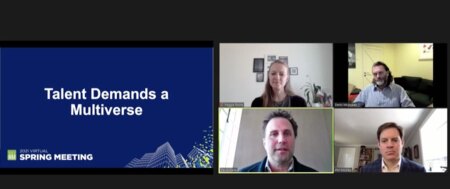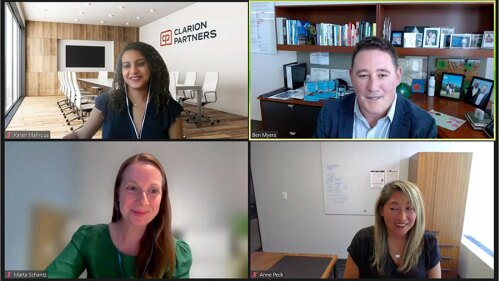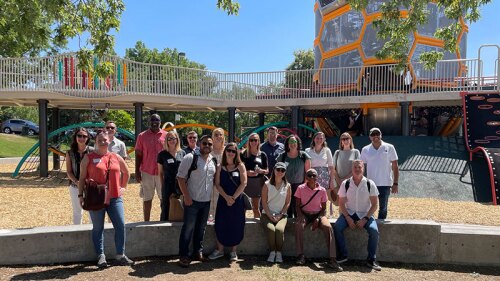The COVID-19 pandemic has challenged us all to rethink everything we thought we knew about productivity and the workplace. As we have learned, the answers are far from straightforward, but they are nevertheless emerging. During a 2021 ULI Virtual Spring Meeting session, real estate experts explored how employees’ preferences and performance are leading to a suite of workplaces—a “multiverse of work” in which homes, corporate offices, and various other locations will combine to enable a high-performing workforce.
Moderator Phil Mobley, director of occupier research at Avison Young, opened the session with the premise that “the workplace is about talent.” “This is nothing new and this was true before our grand work-from-home experience,” he said. “In the last five years, everyone from tenant organizations, occupier organizations all the way through to landlords were investing heavily in making the space attractive to talent. . . . I think it makes sense to think of the workplace not only as a tool for attracting talent, but a tool for helping it to perform better.”
There is a move toward allowing for flexibility, with options for remote working and hybrid working. Will companies that do not allow such flexibility be left behind? Mobley presented a summary of three key findings from a recent research report from Avison Young, which served as the basis for a panel discussion.
Finding No. 1: Talent Demands a Multiverse
In a survey of many thousands of workers by Global Workplace Analytics, 31 percent said that they worked remotely at least once a week before the pandemic. When the survey was repeated during the pandemic, 76 percent said that they wanted to work from home or remotely at least once a week, but only 16 percent said that they wanted to be remote all of the time. Complementary data from Leesman Index said that in terms of how many days a week that staff would want to work in the main workplace post-COVID, 37 percent said zero to one days; 48 percent said two to three days; and 15 percent said four to five days.
“There is no such thing as an average worker or employee,” said Peggie Rothe, chief insights and research officer (CIRO) for Leesman Index, an employee workplace experience assessment benchmark. “Even though, on average, the experience of working from home has been good, there are employees who have not had as equally a good experience. . . . We shouldn’t look at the averages and take them for granted and think they apply to your organization. . . . The numbers may also vary quite a bit within your organization.”
Working remotely does not necessarily need to mean working from home, and the panelists discussed the concept of providing a “third place.” Standard Chartered, a multinational banking and financial services company headquartered in London, has made a deal with IWG, a multinational corporation that provides serviced offices to clients on a contract basis, to provide employees with access to offices closer to workers’ homes to complement the main office and people’s homes.
“For us, ‘third place’ was about responding to the need for choice, and this was very much coming from our staff,” said Denis McGowan, global head of real estate for Standard Chartered. “A lot of the findings we had from surveys were that people want choice, but they want choice both in terms of time and location. . . . I don’t think people will go back to the significant commute times that they had before.”
Finding No. 2: The Multiverse Aids Performance
A second finding from Avison Young’s recent research is that choice in workspace is not only what people want, but it is also what best supports performance. A popular notion of what drives employee performance is the concept of employee engagement. Analysis from Gallup has demonstrated that employees who work either full-time from the office or full-time from home had the lowest levels of engagement, whereas there seems to be a peak when people are splitting time between the two locations. Leesman has demonstrated that there is a split by age, with younger workers in particular wanting more of a connection by being in an office, and older workers generally being more comfortable working from home. A large part is determined by the type of offices available for them to go and work in.
“Where we have invested in our facilities, we have found that our productivity is enhanced by investing in our spaces, providing choice, and providing flexibility both in the office and at home,” said McGowan. “We will continue to give people choice about how, when, and where to work. But when we look at our corporate office going forward, we will be looking at how [employees] still get choice when they come into the office.”
An important issue will concern future-proofing offices and making spaces adaptable with the potential for movable walls and furniture, for example. This does not necessarily require additional space. One of the mantras that Standard Chartered has adopted when thinking about adaptation is “twice the experience, half the space.” David Stella, director of consulting services at Avison Young, was in agreement, saying: “We are using space differently. This idea of environments that allow us to come in and use space on demand, as we need it or as our companies need it, is much more about social connection. It’s about what we cannot get in a Zoom box.”
Finding No. 3: Workplace Quality Matters in the Multiverse
The third finding from Avison Young’s research is that the workplace absolutely matters—not just in terms of its existence, but also in terms of its quality. Perhaps unsurprisingly, when the corporate workplace is good, employees are more likely to want to be in the office to do their work. The Leesman Index has found that companies need to think about the type of spaces that best suit their employees.
“[The best companies] don’t focus just on collaboration at the expense of individual work, Rothe said. “Instead, they focus on all different types of activities. . . . The biggest satisfaction difference in any of the features that we ask about is found in the satisfaction with a variety of different types of workspace.”
So, how should companies best prepare their office space for their employees? One way is to ensure that office space has the ability to morph with an emphasis on flexibility, but Stella emphasized that “there is no manual on this” and encourages clients to do their homework. “It starts with data,” Stella said. “Data drives designs. What data gathering points can we use and are best at predicting future ways to use space and which can help us design accordingly? We’re thinking about neurodiversity and how we start tapping into different ways that people think about space and place to make them effective.”
A final thought from McGowan was that the future of the workplace is going to be an agile sprint: “Every 60 to 90 days, it’s going to morph and we’re going to have to adjust. We don’t know how performance in the space is going to work, so we should accept that sometimes we’re going to get it wrong, and we’ll have to pivot quickly.”





